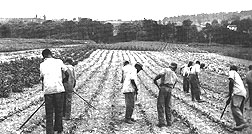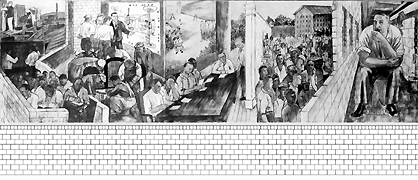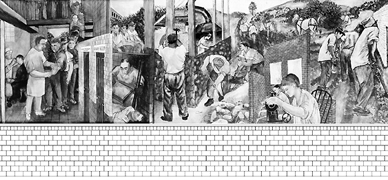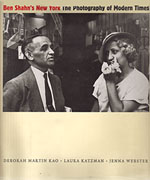
|
|
NYCHS caption: The image, reduced from one in theBen Shahn's New York: The Photography of Modern Times exhibition catalogue, shows inmates tilling field at NYC Reformatory in New Hampton, Orange County.
|
Originally from 8/28/35 issue of the American Federation of Arts' American Magazine of Art. AFA, while retaining all rights, granted NYCHS permission to post excerpts of its magazine's material appearing in "Ben Shahn's New York: The Photography of Modern Times" Exhibition Catalogue:
Philippa Gerry Whiting's "Speaking About Art:
Riker's Island" in
American Magazine of Art
. . . . Recently a case has arisen in New York which is of the utmost importance not only in itself but in its bearing upon all governmental activities in the arts.
This is the rejection by the Municipal Art Commission of the mural sketches by Ben Shahn and Lou Block for the Riker's Island Penitentiary. . . .
|
Thomas Mott Osborne
|
|
Shahn's utopian vision of penal reform begins on the west wall portrait of Osborne, a former Sing Sing warden widely considered the father of 20th century progressive prison-reform. Osborne voluntarily endured a week as an inmate at Auburn Prison. His published account initiated a fundamental revolution in prison administration. Shahn depicts Osborne in his tiny cell, sitting on a wooden stool and contemplating the reformist vision of prison life he would help unfold.
|
They made an exhaustive study of penology, its history and theory, and they were able, with the cooperation of the Commissioner, to sketch and photograph in prisons of all types -- a most unusual privilege.
As a result of their research they prepared a written outline of their plans for the murals, and this outline was carefully considered by the Commissioner, who offered excellent suggestions and corrections.
The work of preparing the sketches proceeded, with frequent consultations with Commissioner M[a]cCormick, who remained very enthusiastic and at no time questioned the fitness of the murals for the walls on which they were destined to be placed.
He made it plain, however, that since the murals for the walls were not merely decorative, since they dealt with important social problems, his approval would have to be sustained by Mayor LaGuardia.
The sketches eventually reached the Mayor, who said that they were a "swell job" and that they would be "a credit to his administration."

|
|
NYCHS caption: The image, reduced from one on the Harvard University Art Museums' Ben Shahn at Harvard, shows some projected west wall mural scenes: (starting from the right) Thomas Mott Osborne in his cell envisioning penal reforms for fellow inmates, limited prisoner self-government, outdoor recreation, academic and vocational training classes.
|
The subject matter of the murals having been judged by the proper authorities, they were submitted to the Municipal Art Commission, whose function is to pass on aesthetic quality.
They were turned down by the Art Commission on the grounds of "psychological unfitness" to be seen by prisoners. Their aesthetic merit was unquestioned. In an effort to have the case reconsidered on the basis of their psychological fitness, a poll of inmates of Welfare Island [Blackwell's Island Penitentiary] was taken under the direction of Commissioner MacCormick.
The Commissioner selected forty representative prisoners; they were given a test suggested by Dr. Shulman, criminal psychologist.
|
Computer Mural
|
|
The Kao Design Group's computerized reconstruction of Shahn's planned mural was done by Deborah Martin Kao with imaging by Michelle Tarsney. Their computer generated images project what Shahnís impressive mural would have looked like in situ had it been painted according to his gouache studies.
|
The sketches were placed on exhibition and were viewed carefully by the prisoners in small groups. . . .
Out of a possible 160 answers [to the four questions asked of the prisoners concerning the sketches proposed for the walls of the new prison], 97 were favorable, 10 unfavorable, 22 indifferent, and 31 left blank . . . .
It is apparently insurmountably difficult to appraise "psychological" factors. In any case the fact that three-fourths of the answers were clearly favorable, and that the test was his own, did not, in the eyes of the Commissioner, constitute "psychological fitness." Which puts the test down as a waste of time except as it makes interesting reading. The sketches for the Riker's Island murals are still in the artists' studios.
They are, potentially, one of the most important mural achievements of a period which is using the mural as never before in this country. They have proved themselves in every possible way, and they will be carried out on twentieth-century New York walls when the New York City administration decides to accept the cooperation of its artists and its prisoners in building a finer social order.

|
|
NYCHS caption: The image, reduced from one on the Harvard University Art Museums' Ben Shahn at Harvard, shows some projected west wall mural scenes including inmates receiving modern medical services and engaged in worthwhile work such as sewing, stone masonry and farming.
|
Originally from 10/28/35 issue of the American Federation of Arts' American Magazine of Art. AFA, while retaining all rights, granted NYCHS permission to post excerpts of its magazine's material appearing in "Ben Shahn's New York: The Photography of Modern Times" Exhibition Catalogue:
Municipal Art Commission president N. Phelps Stokes' response:
Sir: My attention has been called to an article in the August issue of your magazine, in which the writer, Miss Philippa Whiting, an associate editor, criticized the action of the Art Commission of the City of New York in rejecting the mural for Riker's Island penitentiary by Ben Shahn and Lou Block, two artists employed on a PWA (Public Works Administration) project under the auspices of the College Art Association. . .
|
Mural Site Stats
|
|
Shahnís didactic mural in support of progressive penal reform programs was to be painted on the walls of a cavernous hallway that led to the prisonís chapels. The 18-foot-wide corridor measured 100 feet long and provided 12 feet of continuous wall surface above a tiled dado for the proposed fresco.
|
These paintings, which were submitted in elaborate sketch form, depict and contrast prison life of the past with that of the present, and, in the opinion of the Art Commission, to say the least, are lugubrious and unpleasant to look upon.
The article in your magazine and a very similar one, upon which it is evidently based, in the July issue of Art Front, published by the Artists' Union, accuse the Art Commission of having "turned down the designs on the grounds of psychological unfitness," and your article adds: "their aesthetic merit is unquestioned" . . . .
In fairness to the Commission and to Commissioner M[a]cCormick I wish to point out that the designs were disapproved by the Art Commission for one reason -- and for one reason only -- because every member of the Art Commission who was present when the submission was acted upon believed that, artistically, and in other respects, most of them were unsatisfactory and unsuitable for the location for which they were intended and submitted - the main corridor leading to the chapel of the penitentiary, where they would be seen at frequent intervals, not only by the prisoners themselves, but by visitors to the penitentiary, a decision in which the Commissioner concurred.
It should also be recorded that the Art Commission expressed its willingness to consider use of some of the sketches for less public portions of the penitentiary.
[NOTE: Philippa Whiting, the magazine's associate editor, wrote an extended rebuttal ridiculing the reasoning of the Art Commission president's response. The full texts of the Whiting article, Stokes' response and her rebuttal can be found in the Ben Shahn's New York: The Photography of Modern Times Exhibition Catalogue.
The American Federation of Arts, founded in 1909, published the American Magazine of Art until 1953. AFA, while retaining all rights, granted NYCHS permission to post excerpts of its magazine's material appearing in "Ben Shahn's New York: The Photography of Modern Times" Exhibition Catalogue. NYCHS appreciates being permitted to post these excerpts.
To order the Exhibition Catalogue, visit Yale University Press and use 0300083157
as the ISBN search term.
]
|





